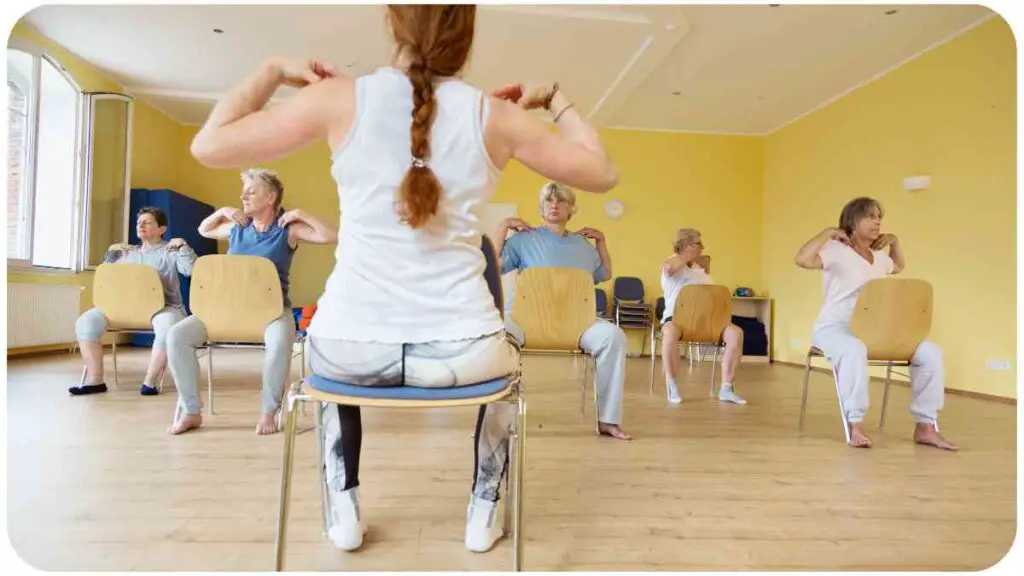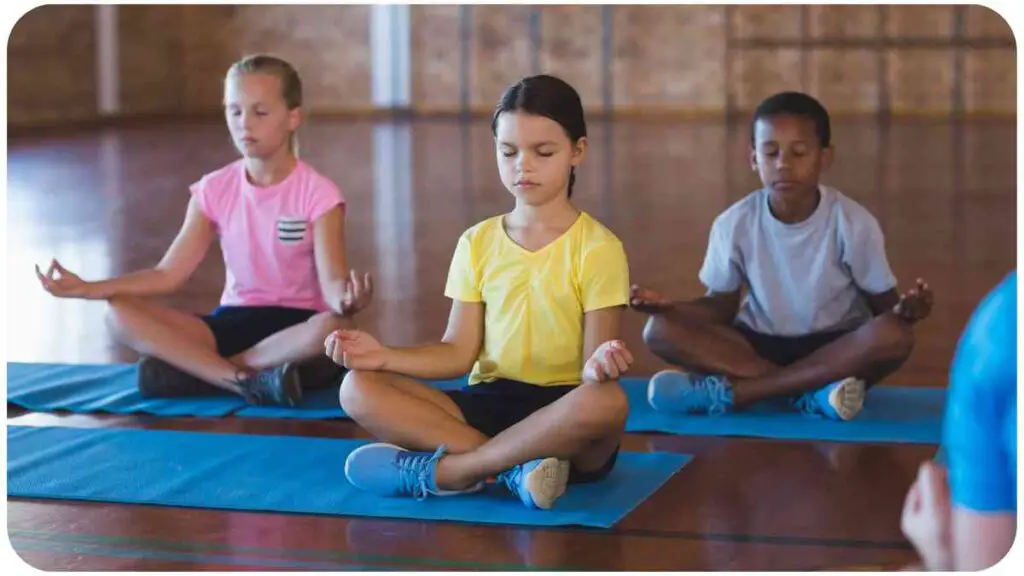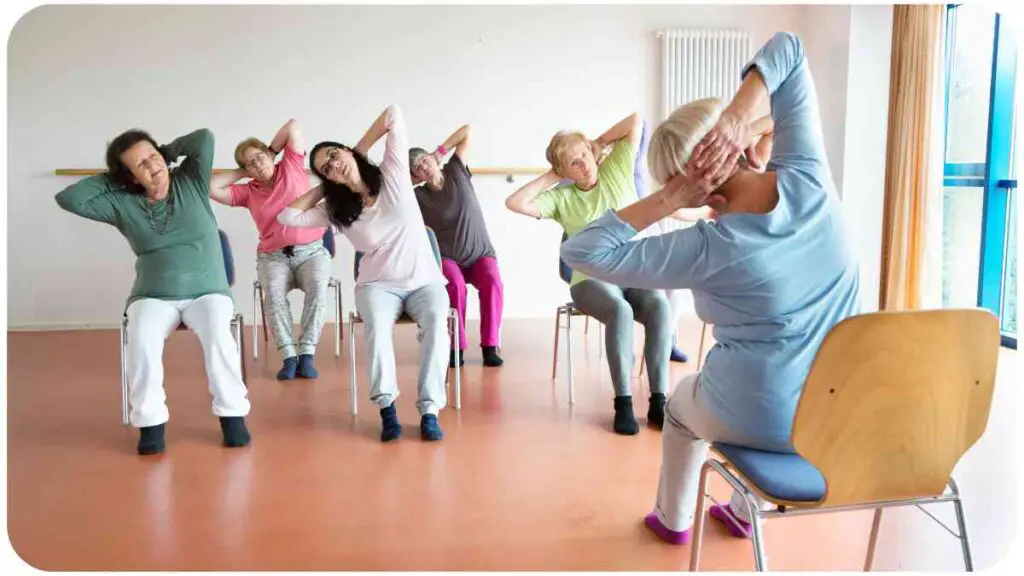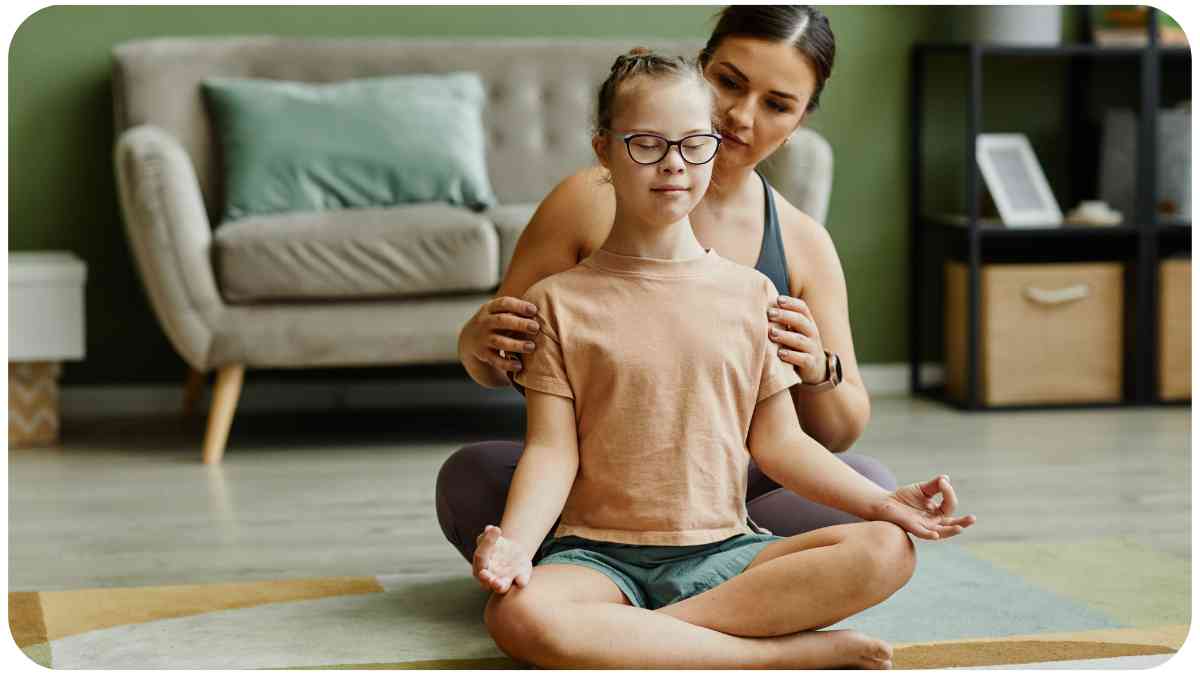In today’s fast-paced world, children often face stress and anxiety. This article explores the benefits of introducing chair yoga to kids, providing an accessible and calming way for them to relax and focus.
Discover how simple chair yoga poses can make a significant difference in your child’s physical and mental well-being.
| Takeaways |
|---|
| Chair yoga for kids offers numerous physical, emotional, and mental benefits. |
| The right choice of poses can promote relaxation, concentration, and strength. |
| Creating a calming environment and incorporating fun elements enhances engagement. |
| Chair yoga can be adapted for different age groups and tailored to individual needs. |
| Consistent practice, patience, and support contribute to a successful chair yoga experience. |
2. Understanding the Benefits of Chair Yoga for Kids
2.1 Physical Benefits
Table: Physical Benefits of Chair Yoga for Kids
| Benefit | Description |
|---|---|
| Improved Flexibility | Enhances range of motion and joint flexibility. |
| Better Posture | Develops awareness and encourages proper alignment. |
| Increased Strength | Builds core and muscle strength in a gentle manner. |
2.2 Emotional and Mental Benefits
Table: Emotional and Mental Benefits of Chair Yoga for Kids
Help your anxious child find peace through calming guided meditations. These simple practices foster serenity and emotional well-being, making them perfect for kids navigating daily stressors
| Benefit | Description |
|---|---|
| Stress Reduction | Promotes relaxation and reduces stress levels. |
| Emotional Regulation | Helps children manage and express their emotions. |
| Increased Mindfulness | Fosters awareness of the present moment. |
2.3 Improved Concentration
Table: How Chair Yoga Enhances Concentration
| Technique | Impact on Concentration |
|---|---|
| Controlled Breathing | Enhances focus and attention. |
| Mindful Movement | Improves the ability to concentrate on tasks. |
| Guided Meditation | Calms the mind, supporting better concentration. |
3. Getting Started with Chair Yoga for Kids

3.1 Choosing the Right Chair
Table: Features of an Ideal Chair for Kids’ Yoga
| Feature | Importance |
|---|---|
| Size and Stability | Ensures safety and comfort for the child. |
| Supportive Backrest | Promotes proper spinal alignment. |
| Non-slip Surface | Prevents accidents during poses. |
3.2 Setting the Mood
Table: Creating a Relaxing Environment for Chair Yoga
Introduce your children to the world of yoga with beginner classes. Designed for young minds, these sessions promote physical health, mental focus, and a joyful approach to wellness.
| Element | Impact on Relaxation |
|---|---|
| Soft Lighting | Sets a calming atmosphere. |
| Gentle Music | Enhances the overall experience. |
| Mindful Breathing | Establishes a tranquil ambiance. |
4. Soothing Chair Yoga Poses for Kids

4.1 Mountain Pose
Table: Steps for Mountain Pose
| Step | Description |
|---|---|
| Sit tall on the chair | Ensure feet are flat on the floor. |
| Inhale and reach arms up | Stretch arms overhead, palms facing each other. |
| Exhale and bring arms down | Repeat several times for a soothing effect. |
4.2 Tree Pose
Table: Tree Pose for Kids
| Step | Description |
|---|---|
| Sit tall with feet grounded | Lift one foot and place it on the inner thigh. |
| Find a focal point | Helps with balance and concentration. |
| Repeat on the other side | Encourages symmetry and stability. |
4.3 Cat-Cow Stretch
Table: Cat-Cow Stretch for Kids
| Step | Description |
|---|---|
| Arch the back (cow) | Inhale and lift the chest, dropping the belly. |
| Round the back (cat) | Exhale and tuck the chin, rounding the spine. |
| Flow between the poses | Repeat for a gentle, rhythmic stretch. |
4.4 Butterfly Pose
Table: Butterfly Pose Steps
| Step | Description |
|---|---|
| Sit with feet together | Hold feet and gently flutter the knees up and down. |
| Encourage a relaxed spine | Promotes flexibility in the hips. |
| Breathe deeply | Enhances the calming effect. |
4.5 Sun Salutation Adaptation
Table: Simplified Sun Salutation for Kids
| Step | Description |
|---|---|
| Reach up to the sky | Inhale and stretch arms overhead. |
| Forward fold | Exhale and reach towards the toes. |
| Return to starting position | Repeat for a flowing sequence. |
4.6 Seated Forward Bend
Table: Steps for Seated Forward Bend
| Step | Description |
|---|---|
| Sit with legs extended | Reach forward towards the toes. |
| Keep a straight spine | Feel the stretch in the hamstrings and lower back. |
| Hold for a few breaths | Encourages relaxation and flexibility. |
4.7 Airplane Pose
Table: Airplane Pose for Kids
| Step | Description |
|---|---|
| Extend arms forward | Lift one leg and lean forward, creating a “T” shape. |
| Engage the core | Builds balance and stability. |
| Repeat on the other side | Develops coordination. |
4.8 Happy Baby Pose
Table: Happy Baby Pose for Kids
Explore the joy of yoga with your kids using no-mat flows. These simple and free practices offer a fun way to enhance flexibility, mindfulness, and family bonding
| Step | Description |
|---|---|
| Lie on the back | Hug the knees into the chest and grab the feet. |
| Rock gently side to side | Relaxes the lower back and hips. |
| Breathe deeply | Calms the nervous system. |
4.9 Chair Relaxation Pose
Table: Steps for Chair Relaxation Pose
| Step | Description |
|---|---|
| Sit comfortably in a chair | Place hands on thighs and close the eyes. |
| Focus on deep breathing | Inhale and exhale slowly, promoting relaxation. |
| Release tension | Encourages a sense of calm and well-being. |
4.10 Guided Meditation for Kids
Table: Elements of Guided Meditation
| Element | Description |
|---|---|
| Calming Imagery | Paint vivid pictures in the child’s mind. |
| Gentle Breathing | Guide rhythmic and relaxed breathing. |
| Positive Affirmations | Reinforce confidence and positivity. |
5. How to Make Chair Yoga Fun and Interactive
5.1 Incorporating Storytelling
Table: Storytelling Ideas for Chair Yoga
| Idea | Description |
|---|---|
| Adventure Narratives | Create yoga adventures with imaginative stories. |
| Animal Kingdom Journeys | Incorporate animal-themed poses into tales. |
| Superhero Quests | Let kids embody superhero qualities through poses. |
5.2 Music and Movement
Table: Musical Chair Yoga Activities
| Activity | Description |
|---|---|
| Yoga Freeze Dance | Incorporate yoga poses into a freeze dance game. |
| Rhythmic Breathing | Match breathing exercises to calming music beats. |
| Sing-Along Poses | Integrate yoga poses with familiar songs. |
5.3 Partner Poses
Table: Partner Chair Yoga Poses
| Pose | Description |
|---|---|
| Mirror Image Pose | Sit facing a partner, mirroring each other’s poses. |
| Partner Breathing | Practice synchronized breathing for connection. |
| Shared Storytelling | Collaborate on creating a joint narrative during poses. |
5.4 Games and Challenges
Table: Chair Yoga Games for Kids
Embark on imaginative yoga adventures with Cosmic Kid. These creative journeys combine storytelling, movement, and mindfulness to engage young minds and promote a love for yoga.
| Game | Description |
|---|---|
| Pose Bingo | Create bingo cards with different yoga poses. |
| Yogi Says | A yoga-inspired version of Simon Says. |
| Memory Pose Match | Match pose cards in a memory game format. |
6. Overcoming Challenges and Common Concerns
6.1 Addressing Restlessness
Table: Strategies to Address Restlessness
| Strategy | Description |
|---|---|
| Incorporate Movement Breaks | Allow short breaks for stretching or movement. |
| Choose Energetic Poses | Opt for poses that release pent-up energy. |
| Use Engaging Props | Introduce props to keep attention focused. |
6.2 Dealing with Distractions
Table: Techniques for Minimizing Distractions
| Technique | Description |
|---|---|
| Establish Clear Expectations | Communicate the importance of focus at the start. |
| Create a Dedicated Space | Designate a quiet area for yoga practice. |
| Use Mindful Reminders | Gently bring attention back to the practice. |
6.3 Encouraging Regular Practice
Table: Tips for Encouraging Consistent Chair Yoga
| Tip | Description |
|---|---|
| Set a Regular Schedule | Establish a routine to create consistency. |
| Celebrate Small Achievements | Acknowledge progress to motivate continued practice. |
| Join in as a Role Model | Participate alongside the child for motivation. |
7. Success Stories: Transformative Chair Yoga Experiences

7.1 Unlocking the Potential of Chair Yoga
a renowned child psychologist, emphasizes the impact of chair yoga on emotional regulation. Through incorporating simple poses into therapy sessions, they’ve witnessed remarkable improvements in children’s self-esteem and coping mechanisms.
Ease your child into a restful night with calming nightly meditations. These soothing practices create a bedtime ritual that promotes relaxation, helping children unwind and embrace peaceful sleep.
7.2 Navigating Emotional Challenges with Chair Yoga
a dedicated advocate for children’s well-being, shares their journey of using chair yoga to help their child navigate emotional challenges. The consistent practice of soothing poses has not only eased stress but has also strengthened the parent-child bond.
8. Tips for Parents and Educators
8.1 Creating a Consistent Routine
Table: Tips for Establishing a Chair Yoga Routine
| Tip | Description |
|---|---|
| Choose a Set Time | Establish a specific time for daily practice. |
| Integrate into Daily Routine | Weave chair yoga seamlessly into existing activities. |
| Be Patient and Consistent | Results may take time, but consistency is key. |
8.2 Encouraging Self-expression
Table: Fostering Self-expression through Chair Yoga
| Approach | Description |
|---|---|
| Allow Creative Expression | Let kids modify poses or create their variations. |
| Share Personal Experiences | Encourage open conversations about feelings. |
| Celebrate Individuality | Embrace the uniqueness of each child’s practice. |
8.3 Staying Patient and Supportive
Table: Tips for Supporting Kids in Chair Yoga
| Tip | Description |
|---|---|
| Offer Encouragement | Praise effort and celebrate small achievements. |
| Be Mindful of Individual Pace | Respect varying abilities and progress. |
| Join in the Fun | Participate to create a positive and inclusive environment. |
9. FAQs About Chair Yoga for Kids
9.1 What Age is Suitable for Chair Yoga?
Table: Age Recommendations for Chair Yoga
| Age Group | Recommendations |
|---|---|
| 3-6 Years | Focus on simple, playful poses and storytelling. |
| 7-10 Years | Introduce more structured poses and breath awareness. |
| 11+ Years | Gradually transition to traditional yoga practices. |
9.2 Can Chair Yoga Replace Traditional Yoga for Kids?
Table: Comparing Chair Yoga and Traditional Yoga for Kids
| Aspect | Chair Yoga | Traditional Yoga |
|---|---|---|
| Accessibility | Ideal for all ages and abilities. | May require more physical strength and agility. |
| Focus on Relaxation | Emphasizes relaxation and mindfulness. | Balances relaxation with physical activity. |
| Incorporating Props | Easily integrates props for support. | May involve fewer props, emphasizing body alone. |
9.3 How Often Should Kids Practice Chair Yoga?
Table: Recommended Frequency of Chair Yoga Practice
| Age Group | Recommended Practice Frequency |
|---|---|
| 3-6 Years | 5-10 minutes daily, with parental involvement. |
| 7-10 Years | 10-15 minutes daily, gradually increasing. |
| 11+ Years | 15-20 minutes daily or 2-3 times per week. |
9.4 Are There Any Safety Concerns?
Table: Safety Guidelines for Chair Yoga
| Safety Aspect | Guidelines |
|---|---|
| Chair Stability | Ensure chairs are sturdy and placed on a flat surface. |
| Supervision | Younger children may need adult supervision. |
| Gentle Guidance | Encourage gentle movements to avoid strain. |
9.5 What if My Child Has Special Needs?
Table: Adapting Chair Yoga for Special Needs
| Special Needs | Adaptations |
|---|---|
| Physical Limitations | Modify poses or use additional props for support. |
| Sensory Challenges | Focus on calming poses and sensory-friendly elements. |
| Attention Difficulties | Break sessions into shorter, more focused intervals. |
10. Additional Resources
10.1 Books on Chair Yoga for Kids
Table: Recommended Books for Further Exploration
| Book Title | Author |
|---|---|
| “Chair Yoga for Little Ones” | Jennifer Cohen Harper |
| “Yoga for Kids and Their Grown-Ups” | Katherine Priore Ghannam |
| “The ABCs of Yoga for Kids” | Teresa Anne Power |
10.2 Online Videos and Tutorials
Table: Online Platforms Offering Chair Yoga for Kids
| Platform | Description |
|---|---|
| Cosmic Kids Yoga | Engaging videos with adventures and yoga practices. |
| Yoga with Adriene – Kids | Online tutorials suitable for various age groups. |
| GoNoodle | Fun and interactive chair yoga routines for kids. |
10.3 Workshops and Classes
Table: Organizations Offering Chair Yoga Workshops
| Organization | Description |
|---|---|
| Little Flower Yoga | Offers workshops and training for educators and parents. |
| The Mindful Child | Focuses on mindfulness practices for children and teens. |
| Yoga Ed. | Provides resources and training for schools and educators. |
11. Conclusion
In conclusion, chair yoga for kids is a valuable tool for promoting physical health, emotional well-being, and concentration. By incorporating simple poses, storytelling, and interactive elements, parents and educators can create a positive and engaging environment for children to explore the benefits of yoga. With the right guidance, chair yoga becomes a fun and accessible way for kids to calm their minds and bodies,
Further Reading
- Calming Yoga Poses for Kids: Explore a variety of calming yoga poses designed specifically for kids. This resource provides detailed instructions and benefits to promote relaxation and mindfulness.
- Calm Down Yoga Poses for Kids: Discover a collection of yoga poses tailored to help children calm down. This resource emphasizes the connection between movement and emotional well-being.
- 9 Calming Yoga Poses for Kids to Promote Relaxation and Mindfulness: Dive into nine calming yoga poses specially curated for kids. This guide focuses on promoting relaxation and mindfulness through playful and engaging poses.
FAQs
What age group is chair yoga suitable for?
Chair yoga is suitable for a wide range of age groups, starting as early as 3 years old. The poses can be adapted to accommodate different developmental stages, making it accessible for kids of various ages.
Can chair yoga help with concentration and focus in children?
Yes, chair yoga can significantly contribute to improved concentration and focus in children. The combination of gentle movements, controlled breathing, and mindfulness practices enhances cognitive abilities and attention spans.
How often should kids practice chair yoga?
The recommended frequency of chair yoga practice depends on the child’s age. For younger children (3-6 years), 5-10 minutes daily with parental involvement is suitable. Older children (11+ years) can aim for 15-20 minutes daily or 2-3 times per week.
Are there any safety concerns associated with chair yoga for kids?
Safety is a priority in chair yoga for kids. Ensuring the stability of chairs, providing supervision for younger children, and offering gentle guidance to avoid strain are key considerations to address safety concerns.
Can chair yoga be adapted for children with special needs?
Yes, chair yoga can be adapted to meet the needs of children with various special needs. Modifications can be made to poses, and sensory-friendly elements can be incorporated to create an inclusive and supportive practice.

